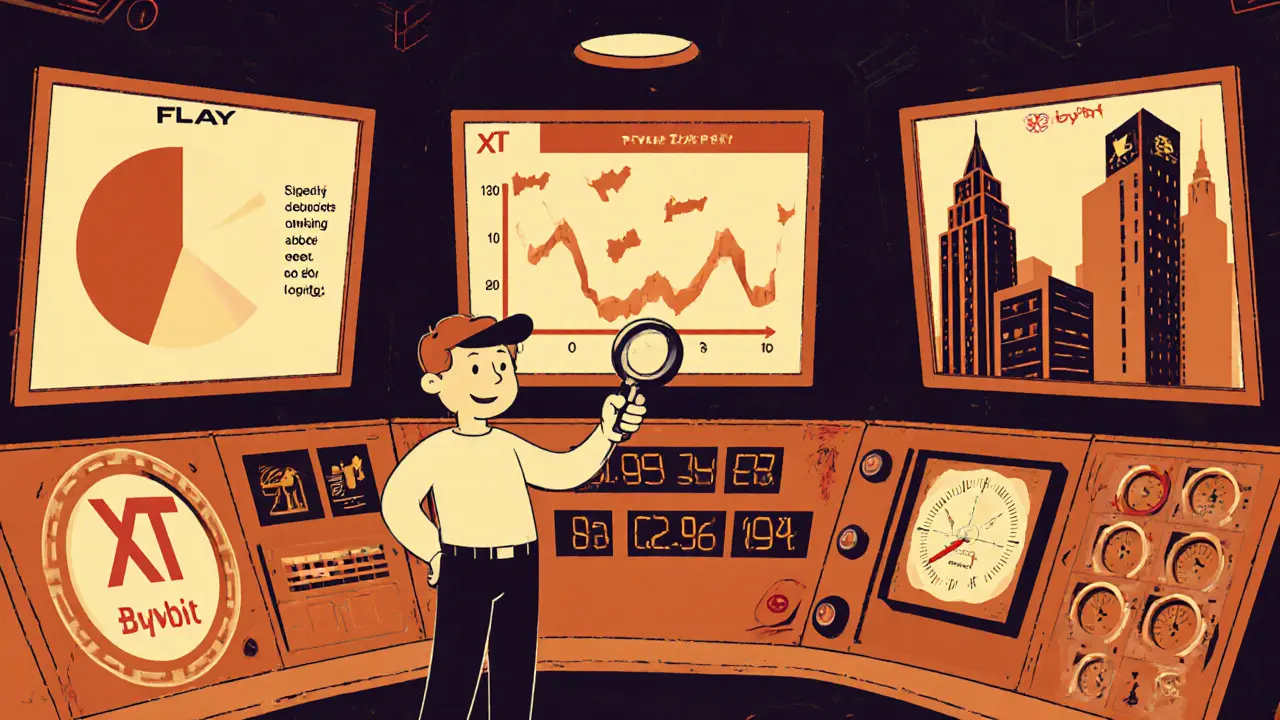Flayer (FLAY) Crypto Coin Explained: Features, Price, and Outlook

May, 6 2025
Flayer Harberger Fee Calculator
How Harberger Fees Work
Harberger Fees are ongoing fees paid by NFT owners based on their self-declared price. The fee is calculated as a percentage of the price they set for their NFT. This encourages honest pricing and creates continuous liquidity for NFT collections.
Enter Your Values
Fee Results
Ever wondered how a crypto token can make NFTs easier to trade? Flayer (FLAY) is an Ethereum‑based ERC20 token that tries to solve exactly that problem. Launched in September 2024, Flayer introduces a continuous‑valuation system called Harberger Fees to keep NFT collections liquid. Below you’ll get the full picture: what the token does, how it’s built, where you can trade it, and whether the market outlook looks bright or bleak.
What is Flayer (FLAY)?
Flayer (FLAY) is a Ethereum blockchain token that follows the ERC20 standard. Its core mission is to provide “fungible liquidity” for non‑fungible token (NFT) collections. In plain terms, Flayer lets owners of a specific NFT pay a small, ongoing fee based on how much they value their asset. That fee, known as a Harberger Fee, forces owners to set realistic prices, making it easier for buyers and sellers to transact at market‑driven rates.
Technical specifications
- Standard: ERC20
- Blockchain: Ethereum
- Total supply: 1,000,000,000 FLAY
- Circulating supply: varies by data source - Bybit shows ~600 M, CoinLore reports 0 (sync issue)
- Mineable: No - distribution came from the initial token sale and ecosystem incentives
Because it lives on Ethereum, Flayer inherits the network’s security, gas‑fee model, and compatibility with existing DeFi protocols and NFT marketplaces.
How Harberger Fees work
Harberger Fees are a tax‑style mechanism invented by economist Arnold Harberger. The idea is simple: anyone who holds an asset must continuously pay a fee calculated as a percentage of the price they themselves set for that asset. If someone else offers to buy it for a higher price, the original holder loses the asset but collects the sale proceeds. This creates a constant incentive to price assets honestly.
In Flayer’s ecosystem, each NFT collection adopts a smart‑contract that automatically collects the fee in FLAY tokens. The fee rate is a protocol parameter (e.g., 1 % per year). When the fee isn’t paid, the contract can seize the NFT and auction it to the highest bidder. The result is a semi‑continuous market where NFTs rarely sit idle without a price.

Market data as of October 2025
| Source | Price (USD) | Market cap (USD) | Rank |
|---|---|---|---|
| Bybit | $0.0382 | $8.24 M | #1 813 |
| CoinLore | $0.0357 | $33.6 M | #3 375 |
| RevenueBot | $0.0421 | $- | #1 342 |
The price swings are typical for a token launched less than a year ago. Its all‑time high hit $0.2713 on CoinCarp in early 2025, then fell more than 80 % to current levels.
Key technical indicators (mid‑October 2025):
- 24‑hour volume: $173,940 - $487,200 (depending on exchange)
- 12‑day volatility: 12.96 %
- 14‑day RSI: 48.71 (neutral)
- 50‑day SMA: $0.030486
- 200‑day SMA: $0.023264
These numbers suggest the token is trading above its long‑term average but below recent peaks, hinting at a modest recovery potential if demand for NFT liquidity rises.
Where can you trade FLAY?
FLAY isn’t on every major exchange yet. The most active markets are:
- XT - identified by CoinGecko as the most popular venue for FLAY pairs
- Bybit - offers FLAY/USDT and FLAY/BTC markets
Because the token isn’t listed on large platforms like Binance or Coinbase, overall liquidity remains limited. No futures, options, or ETF products exist for FLAY, so traders can’t short the token through traditional derivatives. This confines most activity to spot trades.
Flayer compared to other NFT‑liquidity solutions
| Protocol | Launch | Token type | Primary utility | Typical price (USD) |
|---|---|---|---|---|
| Flayer (FLAY) | Sep 2024 | ERC20 | Harberger‑Fee based NFT liquidity | $0.04 |
| NFTX | 2020 | ERC20 | Vault‑based fractional ownership | $0.78 |
| Fractional | 2021 | ERC20 | Collective ownership of high‑value NFTs | $0.12 |
Flayer’s biggest differentiator is the Harberger Fee model, which forces continuous price discovery. NFTX and Fractional rely on vaults or pooled ownership, allowing liquidity but without the same ongoing valuation pressure. If you prefer a market‑driven pricing approach, Flayer stands out; if you need simple fractional shares, the other protocols might feel more user‑friendly.

Risks, challenges, and outlook
Three main hurdles shape Flayer’s future:
- Adoption curve: Users must understand both NFTs and Harberger economics. The concept is still niche, limiting mainstream uptake.
- Exchange presence: Limited listings keep trading volume modest. Broader exchange support would boost liquidity and price discovery.
- Market sentiment: Cryptocurrency markets remain bearish toward NFT‑related projects after the 2022‑2023 correction. Technical analysis (RSI 48, Fear & Greed 48) points to a neutral stance, while price forecasts predict a drop to roughly $0.028 by late 2025.
Despite the challenges, Flayer could benefit from a resurgence in NFT utility (gaming, metaverse, digital ownership). If DeFi protocols start integrating Harberger‑Fee contracts, FLAY may see a demand spike. For now, most analysts advise cautious exposure-perhaps a small allocation for speculative play or short‑selling opportunities, given the projected 31 % ROI for a 109‑day short position.
Quick takeaways
- Flayer (FLAY) is an Flayer FLAY token on Ethereum that uses Harberger Fees to keep NFT prices honest.
- Total supply caps at 1 billion; circulating supply varies by data source.
- Current price hovers around $0.04, far below its $0.27 all‑time high.
- Traded mainly on XT and Bybit; no derivative products yet.
- Key risk: limited adoption and exchange coverage; outlook remains neutral‑to‑bearish in the short term.
Next steps for interested users
If you decide to explore FLAY, follow this simple checklist:
- Set up an Ethereum‑compatible wallet (e.g., MetaMask).
- Buy a small amount of ETH to cover gas fees.
- Create an account on XT or Bybit and locate the FLAY trading pair.
- Transfer your ETH to the exchange, place a market or limit order for FLAY.
- Consider staking or providing liquidity on Flayer’s own protocol if you want to earn the Harberger fee rebates.
Always double‑check the contract address (0x… ) on the official Flayer website before sending funds.
What problem does Flayer aim to solve?
NFTs are unique, so they often lack a liquid market. Flayer introduces a continuous pricing mechanism (Harberger Fees) that encourages owners to set realistic prices, enabling easier buying and selling.
Is Flayer mineable?
No. Like most ERC20 tokens, FLAY was distributed through an initial sale and ecosystem incentives; it does not use proof‑of‑work mining.
Where can I trade FLAY?
The token is listed on XT (the most active venue) and Bybit. It’s not yet on major exchanges like Binance or Coinbase.
How does the Harberger Fee affect NFT owners?
Owners must pay an ongoing fee calculated as a percentage of the price they self‑declare. If someone offers a higher price, the original owner loses the NFT but receives the sale amount, encouraging honest valuation.
Is FLAY a good short‑term investment?
Analysts see a bearish near‑term outlook, with price forecasts around $0.028 by Dec 2025. However, short‑sellers could capture up to 30 % returns if the price continues to fall.
What are the main risks of holding FLAY?
Limited exchange listings, low adoption of the Harberger model, and overall bearish sentiment in the NFT‑related crypto space are the top risks.